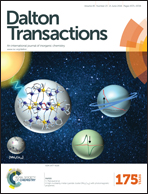Structural, electrochemical and photophysical properties of an exocyclic di-ruthenium complex and its application as a photosensitizer†
Abstract
The reaction of cis-bis(2,2′-bipyridine)dichlororuthenium(II) hydrate with a conformationally mobile bipyridyl macrocycle afforded [(bpy)2Ru(μ-L)Ru(bpy)2]Cl4·6H2O, a bridged di-Ru complex. Single crystal X-ray diffraction showed the macrocyclic ligand adopting a bowl-like structure with the exo-coordinated Ru(II) centers separated by 7.29 Å. Photophysical characterization showed that the complex absorbs in the visible region (λmax = 451 nm) with an emission maximum at 610 nm (τ = 706 ns, ΦPL = 0.021). Electrochemical studies indicate the di-Ru complex undergoes three one-electron reversible reductions and a reversible one-electron oxidation process. This electrochemical reversibility is a key characteristic for its use as an electron transfer agents. The complex was evaluated as a photocatalyst for the electronically mismatched Diels–Alder reaction of isoprene and trans-anethole using visible light. It afforded the expected product in good conversion (69%) and selectivity (dr > 10 : 1) at low loadings (0.5–5.0 mol%) and the sensitizer/catalyst was readily recycled. These results suggest that the bipyridyl macrocycle could be widely applied as a bridging ligand for the generation of chromophore-catalyst assemblies.



 Please wait while we load your content...
Please wait while we load your content...